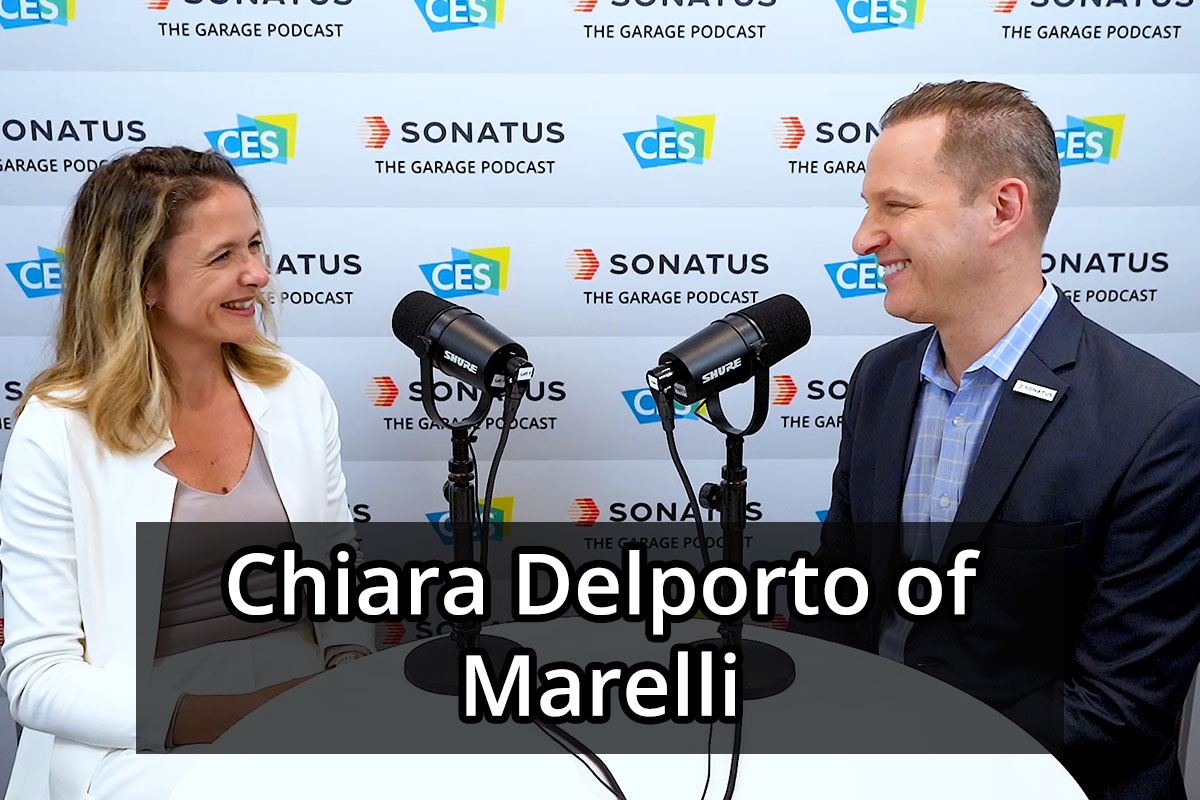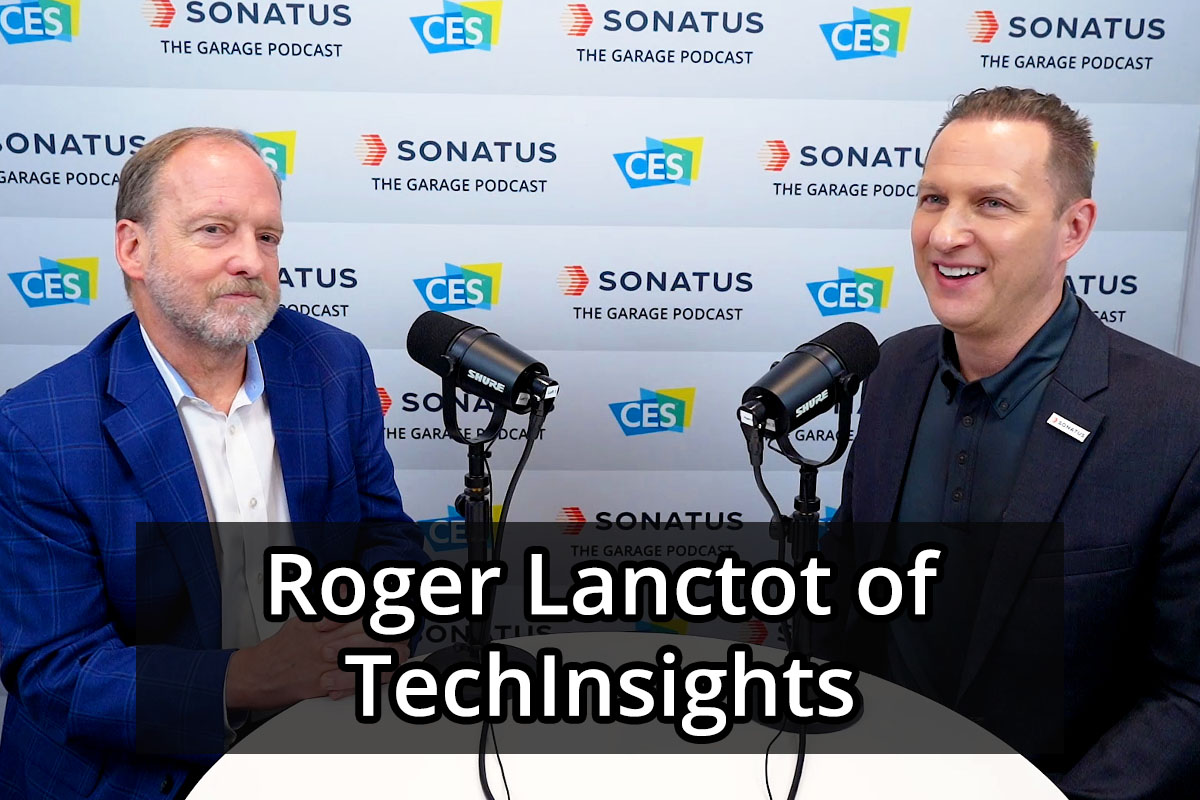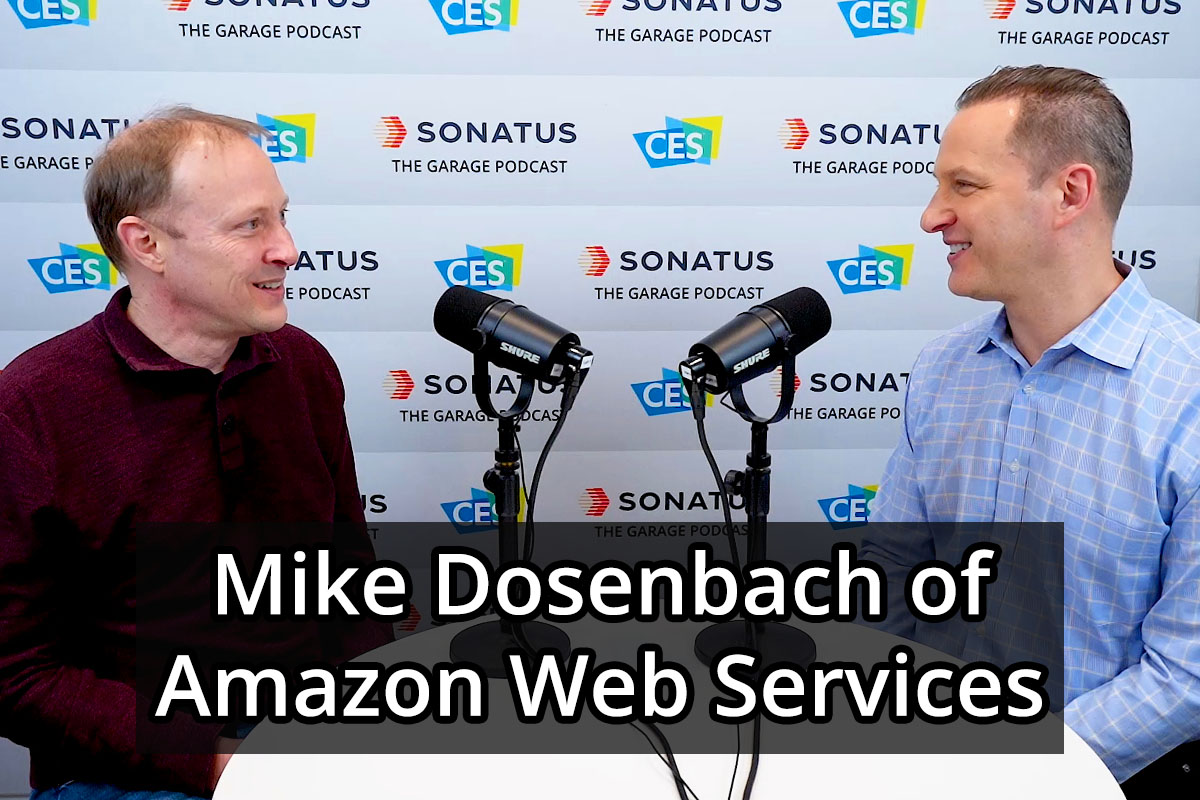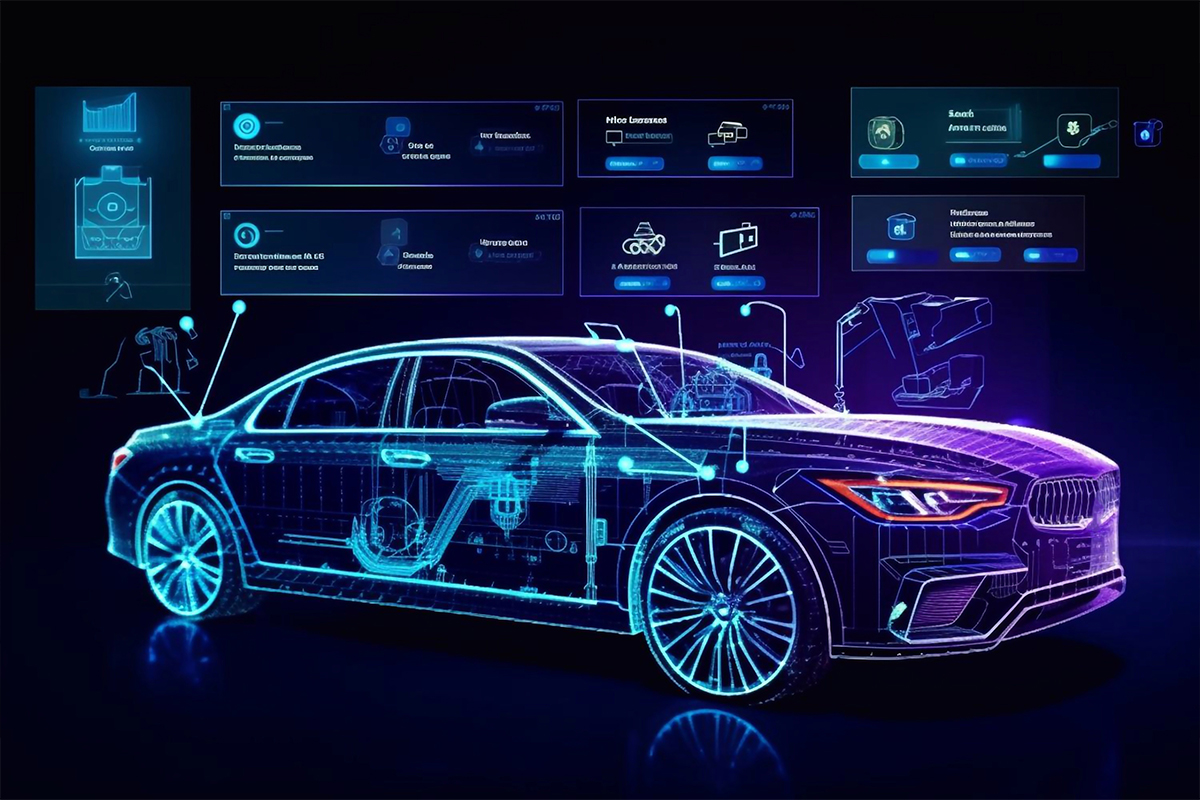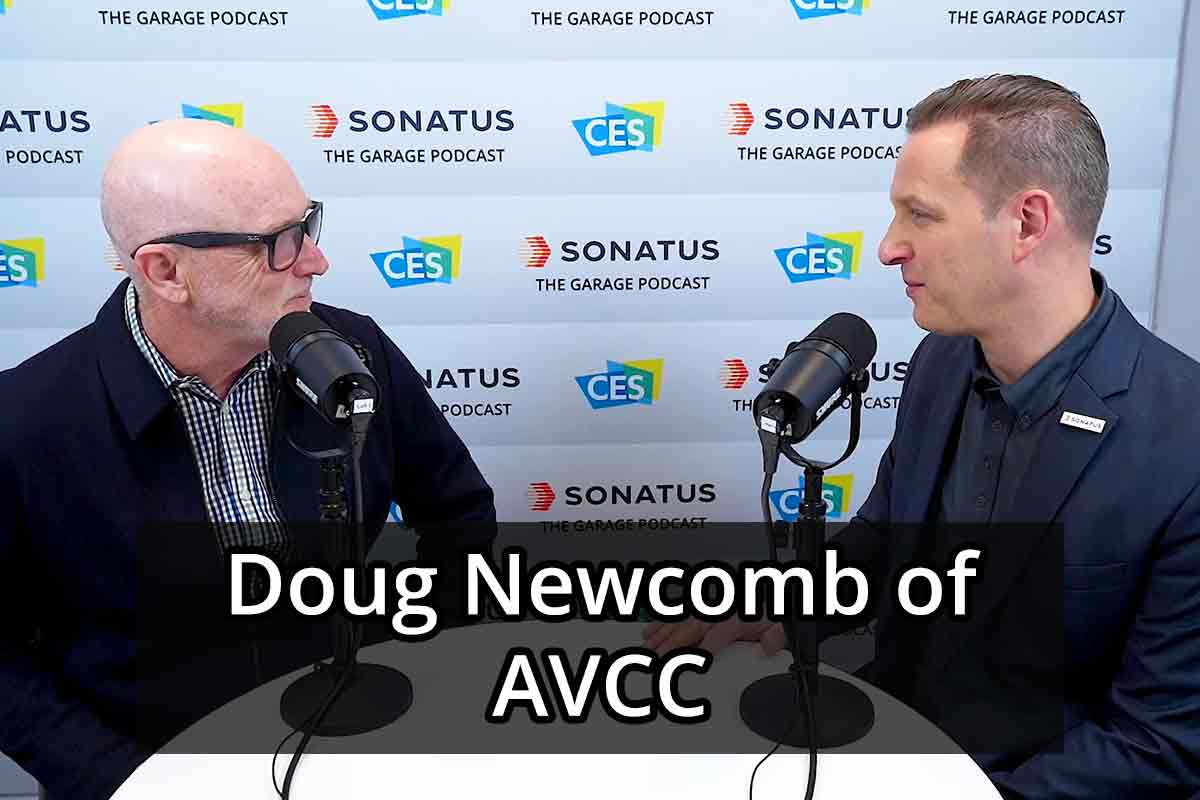Overview
JOHN: We’re live from CES 2024 with AVCC. Let’s go. Hello and welcome to The Garage. We’re recording live at the Consumer Electronics Show 2024, and our guest today is AVCC. We’re so pleased to welcome Doug Newcomb. Doug, welcome to The Garage.
DOUG: Thanks for having me. Happy to be here.
Meet Doug Newcomb
JOHN: Thanks, Doug. Tell us a little bit about you and about AVCC.
DOUG: Sure. Sure. Well, I’ve been a journalist. Or, I am a journalist. I’ve been covering car technology many, many years. My first CES, I’ll say Winter CES, was 1989. If you can believe that. Of course, I started coming when I was ten, so, you know. But yeah, it’s really interesting to see, John, just how the space is changing and, you know, I’ve been here to see it all, you know, over the years. Also, I started an events company in 2013. I was fortunate to have that acquired in 2018, about 18 months before COVID hit.
JOHN: Good for you.
DOUG: Yeah, so I really enjoy doing events. I really enjoy writing about the space. Really enjoy talking with folks like you because it’s just such an exciting time right now in the automotive technology world. For AVCC, what they’re doing is, as you well know, it takes a lot to get a vehicle to drive itself. Automakers and Tier 1 suppliers — the whole ecosystem — has really been struggling to get it right. And it also takes a lot of resources. So what AVCC is doing is coming up, well, first, as a consortium where you have OEMs, Tier 1s, and other stakeholders in the space that participate, that’s an important part in the consortium, and they’re building non-differential IP building blocks to enable self-driving. And that has to do with cybersecurity. It has to do with computing, has to do with machine learning. So think of it as everyone is kind of playing from the same core script and contributing to that, but then they can add their own flavors on top of that. And all in an effort to really accelerate and realize the immense opportunities for self-driving and also to do it in a very cost-effective way.
JOHN: That’s great. So I think we’re going to have a great conversation today.
DOUG: I love talking about this stuff.
JOHN: And, you know, first, I always like to have our guests in The Garage .. I’d like to get to know you as a person as well. Tell us a fun fact about you.
DOUG: Okay. Well, my passion beyond technology is surfing in the water. I spend a lot of time in Mexico surfing. I live in the Pacific Northwest and spend a lot of time kiteboarding. So just, I always say, “Just add water and I’m a happy person.”
JOHN: I must tell you I’m a huge water fan myself. I’ve been a scuba diver for a long time. I was a former scuba instructor, which was fun because I had to make it harder. And my fun fact, I was trying to do a different fun fact every time. My fun fact is, I once went scuba diving with a whale shark, which is sort of every scuba diver’s bucket list item, so I’m really happy about that.
DOUG: Yeah, nice.
AVCC’s mission
JOHN: So, look, I’m very pleased to have you here. Some of our guests may know that I was at ARM for 14 years and AVCC was- Arm helped to found AVCC some years ago and for about a year I was on the board of AVCC. So it’s very close to my heart. I appreciate the mission and I think— and please, I’d love you to jump in—my understanding is AVCC’s mission has really continued to broaden. Because autonomous is still important, but autonomous is only one part of the whole broader computing problem, and the broader assisted-driving problem. So I understand that you’re broadening into include software-defined vehicles, assisted-driving, everywhere in that spectrum. So can you share with me your mission? What are you focusing on?
SDV and vehicle autonomy
DOUG: So as you well know, autonomous vehicle technology doesn’t happen in a vacuum. And there’s so much, what’s the right word, bleed or creep or whatever you want to say, maybe not the best words to use. It’s part of the software-defined vehicle. The automated driving systems are tied into these other parts of the vehicle. So you’re correct. It’s not focusing on one thing. And I think to me, as the software-defined vehicle and the connected vehicle, whatever you want to call it, continues to evolve, autonomy is a very, very important part of that. And whether we’re talking about fully autonomous vehicles or we’re talking about advanced driver assistance systems, it’s all part and parcel of what we’re seeing- in what I feel like is a continually evolving technology revolution in not only cars but in transportation.
JOHN: And I think it’s a misconception some people have when you might say autonomous, you don’t mean what some people say is level four, level five, which is what many people think of as autonomous vehicles, because level two driver assistance, sort of advanced cruise control, level two plus, highway assisted driving at level three, which is limited. That’s all part of- Am I right? Part of the spectrum of autonomy. It’s not just those higher levels.
DOUG: Exactly. Another fun fact about me is I test cars. I’m still a working journalist. I probably test, I don’t know, 50 cars a year. So I get to really see these systems, and how they work in the real world. And it’s so nice, I mean, to get in the vehicle, I mean, whether it’s a Mercedes or a Hyundai or even, well I shouldn’t say even, a Honda or something. And these automated driving systems are so helpful. And I feel like…
JOHN: …And changing so fast….
DOUG: …exactly. And getting so sophisticated. And I think for me, they make driving much more convenient as they do, but they also make driving much more, much safer than… So it’s just, it’s such a…you get so used to, you know, whether it’s adaptive cruise control, lane centering, blind spot detection. So I always keep that in mind as far as what we’re trying to achieve. And to answer your question, automation is a spectrum. From a robotaxi, to a level two, or level three production vehicle.
Infrastructure needed for autonomy
JOHN: Right. Yes. It’s evolving so rapidly. I’ve got a couple of different cars and they…i t’s fun to see the difference in how they handle these different tasks. The lane keeping from one acts a little differently than the other. So I think it’s rapidly changing. But if we go away from the end users and we kind of peel the covers a little bit to look at the technology underneath, there’s a lot of things that have to happen to achieve that. And one of the things that we do at Sonatus, we’re passionate about software-defined vehicles and we’re delivering foundational technologies to help accelerate the shift to SDV. And sometimes we joke that we’re highly paid plumbers because we’re effectively trying to help OEMs address some of the infrastructural things which are frankly sometimes not very sexy, but that they enable you to do these advanced things that we talk about that the consumer loves.
AVCC on ML Benchmarking
JOHN: And I think in the same way, AVCC, as a consortium, is helping to bring together a number of these things. Things like benchmarking, things like common standards, and stuff. So can you tell us about some of the initiatives that AVCC has put out and maybe some that you’re working on now?
DOUG: Sure. One of the things we did last year that I think is very important is partner with MLCommons, which is a consortium focused more on machine learning, focused primarily on machine learning. They’re coming at it from not an automotive perspective, but from a machine learning perspective. So leveraging their benchmarks. Leveraging what they’re doing to, you know, combine and like, you know, one plus one equals three sort of thing where, you know, automakers can learn. They don’t have to do all the work themselves. It’s a group effort where we can establish benchmarks for machine learning that everybody can benefit from. And that again, everybody, I say everybody, the OEMs, the Tier 1s, can sort of add their own flavor, kind of like what you guys are doing with software-defined vehicles. You know, you put the plumbing in, but then maybe, you know, and that’s not the pretty part or the sexy part, but maybe to extend the analogy, put some nice fixtures on the end of that plumbing, the part you do see.
JOHN: Absolutely. And talking about this ML thing, I mean some, one of my very good friends at Arm is helping to lead that ML effort, co-lead it. So I think it’s very important. And I think it’s- I mean people may not appreciate that when we say benchmarks — and my background is in computer architecture so benchmarks is like oxygen for me — we’re talking about a very different kind of benchmark. We’re talking about a benchmark for machine learning. And while perhaps you know, large language models and so on, maybe there’s some growing standards there. When you look more broadly across applying ML to automotive, there aren’t really standard benchmarks, and I think that’s one of the things AVCC was trying to do.
DOUG: Exactly. Where, you know, where David Cantor, who’s started the organization, you know, made it clear. Look, I don’t, you know, I’m not an automotive guy, but again, looking at things that they’re doing, leveraging the work that they’re doing, and you’re absolutely correct, where automakers can use these benchmarks that are done over a wide area of applications. It’s very interesting. I was talking to one gentleman from Bosch. I can’t remember his name right now, but he was saying how it’s getting so sophisticated. You should look this up. I would encourage your audience to look this up. There’s a guy who’s on the back of a taxi. I know it, sounds crazy, but look it up with an ironing board in New York City. And the machine learning identified exactly what it was. It’s gotten to the point where it can very much pinpoint what, and I had to look it up, I couldn’t believe it. But that’s an example of where if the machine learning- When you established these benchmarks, it helps it- You know, again the cliche of rising tide lifts all boats. Rather than each company, OEMs or Tier 1s, doing this work themselves, they can benefit from…
JOHN: Yeah, this non-differentiating thing is something we often talk about from Sonatus as well. Because there’s a lot of these foundational layers, and Arm as well, before that as well, because Arm does a lot of incredible engineering. And historically at Arm, people- companies would have done their own processor. Their own instruction set. Maybe people that had their own fab. What was the point of that? There’s no- it’s non differentiating. And so Arm says “look, reuse this incredible software”. Well Sonatus is doing the same thing. We’re providing a lot of these software foundational layers for things like advanced network management, and advanced data collection, and advanced automation. That then it’s not solving the whole problem, but it’s giving the OEMs, I like to say, a higher place to stand just to begin their work and to do their own differentiation. I think some of the things you’re talking about are very similar to that.
Other AVCC Initiatives
DOUG: Another important aspect of AVCC, I’d point out, one of our working groups is cybersecurity. Like plumbing, it’s not super sexy, but you know, it’s essential.
JOHN: But it’s important, it’s essential.
DOUG: Exactly. I mean, that’s one of the first questions I get from laypeople, interesting enough, like about how secure are these things? You know? So I think that’s one of the important things that we’re doing. We’re actually launching an AI initiative because here we are at CES. And AI is a buzzword. We’re launching a working group on AI again, that members of the stakeholders in the industry can collaborate to learn together.
JOHN: That’s really interesting. What other initiatives are you focusing on in 2024?
DOUG: One is TCO, Total cost of ownership. Because we know working in the auto industry it’s very important. So what AVCC is doing in that initiative is working with its members to drive costs down. When I say that- so that they’re not spinning their wheels in a sense. They can work from these benchmarks, from these collaborative efforts to deliver products much less extensively than they would otherwise. Another one is software portability, as you guys well know at Sonatus, it’s a very important aspect. So that’s another thing we’re working on.
JOHN: Yeah, software portability is so important, we’re pleased at Sonatus to be very hardware-agnostic. We work on top of a wide range of software- hardware platforms, actually. Most of them based on Arm, but really across a wide range of platforms. Because OEMs increasingly want to be able to write their software without being handcuffed to any one platform, any one, in fact, even Tier 1. Often these days they want to have a little bit more autonomy, but really the richness of the whole ecosystem they need. And I know with AVCC when I was there, we spent a lot of time on how OEMs can, as you said, optimize TCO by designing things in such a way that they’re not write once and throw away, they are re-usable.
Membership in AVCC
DOUG: That’s a perfect example of the TCO- All these things kind of work together. But software portability is a great example of, you know, TCO, total cost of ownership. And I think the important thing is people should realize with any organization, but with AVCC in particular, is getting involved. Really, I think people should look at it, when I say people, stakeholders in the industry, meaning people from OEMs, people from Tier 1s, people from startups, people from even government organizations or universities. We have people as well from-
JOHN: I know you have a very diverse membership.
DOUG: Exactly. This is a chance to be involved. To really help shape the future of this technology. And I think also to- everything we talked about. To really enable it. And that’s one of the things I really go back to, John, is I mean, I love the space, I love the technology, I love being here at CES and talking with people like you. But, you know, I’m thinking about really the greater good. What we can do in society. I mean, I often tell people, you know, over 40,000 people a year die in auto accidents. That’s just in the U.S. So I really feel like a lot of this technology we’re developing through organizations like AVCC, you know, of course, it will save money. Of course, it will make driving more convenient, but it really will save lives. But I feel like that’s my kind of call to action for people in the industry to get involved for multiple reasons. One, to be on the ground floor of what’s happening in, and on the cutting edge, of autonomous and automated vehicle technology and software-defined technology. But you know, all the benefits that come with that. But also, again, I kind of keep in mind these societal benefits.
Conclusion
DOUG: But it’s- you have the chance- and you, the people, the members of AVCC, have the chance to write history in a sense, to, you know, not sound dramatic, but to really get- we started out the conversation talking about how difficult it is to get automated vehicle technology correct. We’ve seen a lot of examples of that, but I feel like we’re so close. You know, I remember I always think about that, we’re past the easy part.
JOHN: That’s true.
DOUG: Now it’s like the hard part. And we’ll get there. We will get there, you know, but not without this kind of collaboration.
JOHN: That’s quite an uplifting way to end the podcast. Hey, I appreciate you. Thank you for joining us. Thanks for being here. Great work and good luck with continuing a great membership in AVCC.
DOUG: Thanks for having me. It’s been really enjoyable.
JOHN: My pleasure. If you’re enjoying what you’re seeing on The Garage, we hope you’ll like this episode and subscribe to see more. Look for other episodes coming from the Consumer Electronics Show 2024. We hope to see you again very soon.
